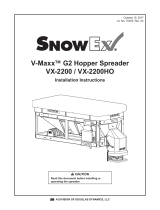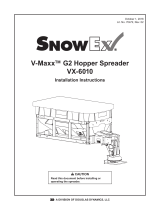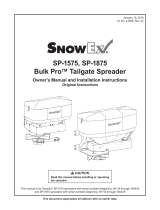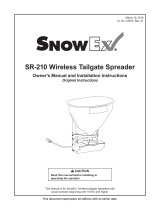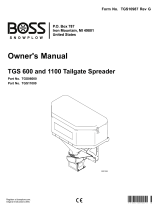Page is loading ...

February 24, 2020
Lit. No. 76452, Rev. 04
Tornado™ UTV Hopper Spreader
#78600
Installation Instructions
These Installation Instructions are for WESTERN® Tornado UTV hopper spreaders
with serial numbers beginning with 160901 and higher.
Western Products, PO Box 245038, Milwaukee, WI 53224-9538 • www.westernplows.com
A DIVISION OF DOUGLAS DYNAMICS, LLC
CAUTION
Read this document before installing
or operating the spreader.


Lit. No. 76451/76452/76453, Rev. 04 3 February 24, 2020
SAFETY
• Read Owner’s Manual for Installation Instructions.
• Secure spreader to truck with ratchet straps.
• Anchor spreader securely to truck body with bolt kit provided to
prevent slipping or sliding.
• Routinely check straps and handware to make sure they are secure.
D6548
ROTATING PARTS AND FLYING OB-
JECTS CAN CAUSE INJURY OR DEATH
• Keep hands, arms, feet and loose clothing away
• Shut o power ans stop engine before servicing
• Read owners manual before operating.
• Keep bystanders at least 60 ft away.
D6544
SAFETY DEFINITIONS
NOTE: Indicates a situation or action that can
lead to damage to your spreader and vehicle or
other property. Other useful information can also
be described.
WARNING/CAUTION LABELS
Become familiar with and inform users about the
warning and caution labels on the spreader.
NOTE: If labels are missing or cannot be read, see
your sales outlet.
CAUTION
Indicates a potentially hazardous situation
that, if not avoided, may result in minor or
moderate injury. It may also be used to alert
against unsafe practices.
WARNING
Indicates a potentially hazardous situation
that, if not avoided, could result in death or
serious personal injury.
NO STEP
• Slippery Surface When Wet.
• May Cause Severe Injury
D6545

Lit. No. 76451/76452/76453, Rev. 04 4 February 24, 2020
SERIAL NUMBER LABEL
SAFETY
ROTATING AUGER CAN CAUSE
SERIOUS INJURY OR DEATH
• Keep arms, hands, and loose clothing
away from auger.
• Shut o control and unplug spreader
before servicing. D6335
Code Defi nition
YY 2-Digit Year
MM 2-Digit Month
DD 2-Digit Day
LL 2-Digit Location Code
XXXX 4-Digit Sequential Number
ZZZZZZ 5- to 7-Digit Assembly PN

Lit. No. 76451/76452/76453, Rev. 04 5 February 24, 2020
SAFETY
SAFETY PRECAUTIONS
Improper installation and operation could cause
personal injury and/or equipment and property damage.
Read and understand labels and the Owner's Manual
before installing, operating, or making adjustments.
WARNING
• Driver to keep bystanders minimum of
25 feet away from operating spreader.
• Before working with the spreader, secure all
loose-fi tting clothing and unrestrained hair.
• Before operating the spreader, verify that all
safety guards are in place.
• Before servicing the spreader, wait for
conveyor, auger, and spinner to stop.
• Do not climb into or ride on spreader.
CAUTION
If rear directional, CHMSL light, or brake
stoplights are obstructed by the spreader, the
lights shall be relocated, or auxiliary directional
or brake stoplights shall be installed.
WARNING
Overloading could result in an
accident or damage. Do not
exceed GVWR of UTV. See
Loading section to determine
maximum volumes of spreading material.
CAUTION
Disconnect electric and/or hydraulic power
and tag out if required before servicing or
performing maintenance.
NOTE: Lubricate grease fi ttings after each use.
Use a good quality multipurpose grease.
FUSES
The electrical system contains several automotive-style
fuses. If a problem should occur and fuse replacement
is necessary, the replacement fuse must be of the
same type and amperage rating as the original.
Installing a fuse with a higher rating can damage the
system and could start a fi re.
CAUTION
DO NOT leave unused material in
hopper. Material can freeze or solidify,
causing unit to not work properly.
Empty and clean after each use.
CAUTION
• Do not operate a spreader in need of
maintenance.
• Before operating the spreader, reassemble
any parts or hardware removed for cleaning
or adjusting.
• Before operating the spreader, remove
materials such as cleaning rags, brushes,
and hand tools from the spreader.
• Before operating the spreader, read the
engine owner's manual, if so equipped.
• While operating the spreader, use auxiliary
warning lights, except when prohibited by law.
• Tighten all fasteners according to the
torque chart. Refer to torque chart for the
recommended torque values.
WARNING
Vehicles <10,000 lb GVWR: Obstructing the
visibility from the vehicle's rear camera could
result in serious injury or damage. An auxiliary
camera system shall be installed if the
vehicle's rear camera is removed or blocked.

Lit. No. 76451/76452/76453, Rev. 04 6 February 24, 2020
BATTERY SAFETYPERSONAL SAFETY
• Remove ignition key and put the vehicle in PARK
or in gear to prevent others from starting the
vehicle during installation or service.
• Wear only snug-fi tting clothing while working on
your vehicle or spreader.
• Do not wear jewelry or a necktie, and secure
long hair.
• Wear safety goggles to protect your eyes from
battery acid, gasoline, dirt, and dust.
• Avoid touching hot surfaces such as the engine,
radiator, hoses, and exhaust pipes.
• Always have a fi re extinguisher rated BC handy,
for fl ammable liquids and electrical fi res
SAFETY
FIRE AND EXPLOSION
Be careful when using gasoline. Do not use gasoline
to clean parts. Store only in approved containers away
from sources of heat or fl ame.
CELL PHONES
A driver's fi rst responsibility is the safe operation of
the vehicle. The most important thing you can do
to prevent a crash is to avoid distractions and pay
attention to the road. Wait until it is safe to operate
Mobile Communication Equipment such as cell phones,
text messaging devices, pagers, or two-way radios.
VENTILATION
WARNING
Gasoline is highly fl ammable and gasoline
vapor is explosive. Never smoke while
working on vehicle. Keep all open fl ames
away from gasoline tank and lines. Wipe up
any spilled gasoline immediately.
CAUTION
Batteries normally produce explosive gases
which can cause personal injury. Therefore,
do not allow fl ames, sparks, or lit tobacco
to come near the battery. When charging or
working near a battery, always cover your
face and protect your eyes, and also provide
ventilation.
• Batteries contain sulfuric acid, which burns
skin, eyes, and clothing.
• Disconnect the battery before removing or
replacing any electrical components.
WARNING
Vehicle exhaust contains lethal fumes. Breathing
these fumes, even in low concentrations,
can cause death. Never operate a vehicle in
an enclosed area without venting exhaust to
the outside.
TORQUE CHART
1/4-20 109 154
1/4-28 121 171
5/16-18 150 212
5/16-24 170 240
3/8-16 269 376
3/8-24 297 420
7/16-14 429 606
7/16-20
9/16-12
9/16-18
5/8-11
5/8-18
3/4-10
3/4-16
7/8-9
7/8-14 474 669
644 9091-8
1-12 704 995
1/2-13
1/2-20
11.9
13.7
24.6
27.3
43.6
26.9
53.3
93
148
49.4
69.8
77.9
106.4
120.0
8.4
9.7
17.4
19.2
30.8
35.0
49.4
55.2
75.3
85.0
M6 x 1.00
M12 x 1.75
M8 x 1.25
M14 x 2.00
M10 x 1.50
M27 x 3.00
M22 x 2.50
M30 x 3.50
M24 x 3.00
M20 x 2.5011.1
19.5
38.5
67
107
7.7
613
778
1139
1545
450
428
562
796
1117
M33 x 3.50
M36 x 4.00
2101
2701
1468
1952
325
M16 x 2.00 231
167
M18 x 2.50 318222
Recommended Fastener Torque Chart
Size Size
Torque (f t- lb)
Grade
5
Grade
8
Metric Fasteners Class 8.8 and 10.9
These torque values apply to fasteners
except those noted in the instructions.
Torque (f t- lb)
Grade
5
Grade
8
Size Size
Torque (f t- lb)
Class
8.8
Class
10.9
Torque (f t- lb)
Class
8.8
Class
10.9
Inch Fasteners Grade 5 and Grade 8
CAUTION
Read instructions before assembling. Fasteners
should be fi nger tight until instructed to tighten
according to the torque chart. Use standard
methods and practices when attaching
spreader, including proper personal protective
safety equipment.

Lit. No. 76451/76452/76453, Rev. 04 7 February 24, 2020
DETERMINING VEHICLE PAYLOAD
1. Install the hopper spreader and optional
equipment according to the instructions.
2. Install or attach any other equipment that will be
on the vehicle while the hopper spreader will be in
use (step bumper, trailer hitch, snowplow, etc.). Fill
gas tanks.
3. Obtain the Gross Vehicle Weight Rating (GVWR)
from the UTV manufacturer.
4. With the occupants in the truck for normal hopper
spreader operation, weigh the vehicle to obtain
gross vehicle weight (GVW).
5. Subtract the GVW from the GVWR to determine
the available material payload.
6. Obtain the weight per cubic yard (lb/yd³) of the
desired material. Divide the weight into the
payload to determine the maximum volume of
material that can be carried.
7. Fill the hopper with the calculated volume of material.
Reweigh the vehicle with occupants and verify that
the GVW is less than the vehicle's ratings.
8. Repeat Steps 6 and 7 for each type of material.
CAUTION
Never use wet materials or materials with
foreign debris with any of these spreaders.
These units are designed to handle dry, clean,
free-fl owing material.
These instructions cover vehicles that have been
recommended for carrying the hopper spreader. Please
see your local dealer for proper vehicle applications.
CAUTION
Read and adhere to manufacturer's
ice-control material package
labeling, including Safety Data
Sheet requirements.
MATERIAL WEIGHTS
Density
Material (lb/ft3)(lb/yd
3)(kg/m
3)
Salt 80 2160 1282
Sand 100 2700 1602
Material densities are approximate and are based on dry,
loose material. It is the responsibility of the operator to
know the weight of the material to be spread and the vehicle
carrying capacity.
WARNING
Overloading could result in an accident or
damage. Do not exceed GVWR of UTV.
LOADING

Lit. No. 76451/76452/76453, Rev. 04 8 February 24, 2020
4. Install the chute/defl ector assembly to the spinner
assembly using the four 5/16" x 1-1/2" tapping
screws and 5/16" locknuts in the supplied
hardware kit to complete the drive assembly.
5. Mount the drive assembly to the spreader using
the 1/2" x 17-5/8" bent pin and secure it with the
2-3/8" hairpin cotter. Ensure that the bent pin
passes through the small center mounting tab on
the auger drive enclosure.
6. Slide the spreader forward until the defl ector/chute
assembly makes contact with the vehicle. Then
slide spreader back approximately 1" to allow
proper clearance.
7. Once the spreader is positioned front to back in
the vehicle bed, center it left to right.
MOUNTING THE SPREADER
MOUNTING SPREADER
NOTE: Periodically throughout the snow and ice
control season, verify that mounting devices are
secure.
1. Remove the tailgate from the UTV bed.
2. Load the spreader onto the UTV bed.
3. Assemble the chute to the defl ector using the
four 1/4" x 3/4" serrated fl ange cap screws and
1/4" locknuts in the supplied hardware kit.
WARNING
Spreader shall be bolted to vehicle frame.
Do not rely on the tie-down chains or straps
alone to hold spreader in vehicle.
CAUTION
Before lifting, verify that hopper is empty of
material. The lifting device must be able to
support the spreader's weight. Defl ector
Spinner
Assembly
Defl ector
Chute

Lit. No. 76451/76452/76453, Rev. 04 9 February 24, 2020
MOUNTING THE SPREADER
8. Looking at the inside corners of the spreader
frame, you will notice four holes in the bottom of
the frame. Using a paint pen or similar marking
device, mark the hole locations on the vehicle bed.
If mounting holes cannot be drilled in the
marked locations, install the optional mounting
bars to the spreader frame using the supplied
1/2" x 1-1/2" carriage bolts and 1/2" locknuts. Use
the existing holes in the mounting bars to mark
drilling locations on the vehicle bed.
9. Remove the spreader from the vehicle bed and
drill 1/2" holes at the marked locations.
NOTE: Pay special attention when drilling or
clamping dissimilar metals to aluminum bodies.
Galvanic corrosion can occur if not handled
properly. Contact vehicle manufacturer for
recommended attachment practices.
10. Install the spreader to the vehicle using the
supplied 1/2" x 3" carriage bolts and 1/2" locknuts.
11. Tighten all fasteners according to the torque chart.
12. Install the four ratchet straps as shown below.
NOTE: It is important for safety that this strapping
method be used as the standard mounting
procedure.
CAUTION
Before drilling holes, check to be sure that no
vehicle wiring or other components could be
damaged.
Ratchet Strap
Cross straps
and secure
to UTV bed.
Optional
Mounting Bars

Lit. No. 76451/76452/76453, Rev. 04 10 February 24, 2020
WIRING INSTRUCTIONS
1. Remove the vehicle fl oor pan and battery cover. If
possible, tip up the bed and lock it in place.
2. Route the vehicle cable assembly along the vehicle
frame from the rear of the vehicle to the front. Make
sure that the path avoids any hot, sharp, or moving
parts of the vehicle. Cable tie the harness to the
frame holes and frame supports. Do not attach to
fuel or brake lines.
3. Mount the rear plug to the bumper using the
supplied bracket and fasteners. Position the
plug toward the center of the bumper to reduce
exposure to debris thrown up by the tires.
4. Install the dust cover and secure the pigtail to
the harness mounting bracket using the existing
fasteners.
NOTE: Apply a small amount of dielectric grease
to the plug. Try to mount the plug facing upward
to help keep it tightly sealed.
WIRING AND HARNESS INSTRUCTIONS
5. Route the ignition wire and connect it. Consult
UTV wiring diagram to locate a suitable ignition
wire connection. Secure the harness from the rear
to the battery using heavy-duty cable ties or frame
clips along the frame and lighter duty cable ties
everywhere else. Attach the relay assembly to the
fender wall in a safe area.
6. Pass the remaining harness into the cab under
the fl oor pan. On the passenger's side of the
centerline of the UTV, at the lower portion of the
front cab where the fl oor mats meet the fi re wall,
choose a location for the harness to be routed
into the cab. Before drilling, check the area on
the other side of the fi re wall to make sure that no
wiring or control module could be damaged.
Drill and slot a 1" hole such that the harness can
pass into the cab when the fl oor pan is reinstalled.
7. Connect power leads to the battery:
Red: POSITIVE (+)
Black: NEGATIVE (–)
Always connect to the primary battery if using a
dual battery system. Secure loose loom to any
other large or medium vehicle harness using
medium-duty cable ties to secure the wiring
harness.
CAUTION
Before drilling any holes, check both sides
of the material for any wires, fuel lines, fuel
tanks, etc., that may be damaged by drilling.

Lit. No. 76451/76452/76453, Rev. 04 11 February 24, 2020
Vehicle Control Harness Installation
Choose a mounting location where the control will
be within easy reach of the vehicle operator and
will not restrict access to vehicle controls or vehicle
instrumentation. Do not mount the control in areas
prohibited by the vehicle manufacturer for crash
worthiness. See the vehicle's owner's manual or
service manual for details.
NOTE: You may want to contact Technical Support
before mounting the control if you prefer not to
drill holes into the dashboard.
1. Install the control bracket in the mounting location
using the provided tapping screws.
2. Install the control to the control bracket using
1/4" x 1-1/2" cap screws, nylon washers, and
steel washers.
3. Connect the harness to the back of the control.
Cable tie loose control harness securely below the
fl oor pan. Do not mount close to any heater vents.
4. Connect the spreader power cord to vehicle main
power plug mounted at the rear of the vehicle.
CAUTION
Before drilling into dash, verify no harnesses,
relays, or other vehicle components can be
damaged by drilling.
WIRING AND HARNESS INSTRUCTIONS
5. Push the ON/OFF switch on the control to check
for power. After power has been confi rmed, push
the ON/OFF switch again to turn the control
OFF. The electrical portion of the installation is
complete.
NOTE: Use dielectric grease on all electrical
connections.
NOTE: In the off -season, remove the control and
store in a cool, dry place. The interior summer
temperatures could damage circuit board and
void warranty.
NOTE: Do not modify harness length. Any
modifi cations will void warranty.
• Apply dielectric grease to all external connections.
• Read lead labels before attaching to power source
or ground.
• No other devices may be spliced into wiring
harness.
• Any repairs to wiring harness must be done with
heat-shrink butt connectors.

Lit. No. 76451/76452/76453, Rev. 04 12 February 24, 2020
HARNESS WIRING DIAGRAM
Spreader Control
Control Mounting Bracket
UTV Harness Spreader
Harness
1/4" x 1/2"
Cap Screw
Power Cable

Lit. No. 76451/76452/76453, Rev. 04 13 February 24, 2020
Spreader Harness
Control
Load
View
NEGATIVE (–) POSITIVE (+)
Vibrator NEGATIVE (–)
Auger NEGATIVE (–)
Spinner NEGATIVE (–)
Spinner POSITIVE (+)
Auger POSITIVE (+)
Vibrator POSITIVE (+)
Load
View
Auger
Black NEGATIVE (−)
Spinner
Black NEGATIVE (−)
Vibrator
Black NEGATIVE (−)
Spinner
Red POSITIVE (+)
Vibrator
Red POSITIVE (+)
Red
POSITIVE (+)
Black
NEGATIVE (−)
Auger
Red POSITIVE (+)
Chute
Auger
Vibrator
HARNESS DIAGRAM

Lit. No. 76451/76452/76453, Rev. 04 14 February 24, 2020
Spinner
Main Input
Auger and vibrator not shown.
ELECTRICAL ROUTING
Under side of spinner
and trough.

Lit. No. 76451/76452/76453, Rev. 04 15 February 24, 2020
FINAL ADJUSTMENTS
FINAL CHECKLIST
Verify that dielectric grease is applied to all
electrical connections.
Verify that wire harnesses and battery cables are
properly secured away from sharp, hot, or moving
parts.
Verify that the vehicle wiring harness has suffi cient
ground clearance when the spreader is removed
from the UTV.

A DIVISION OF DOUGLAS DYNAMICS, LLC
Western Products
PO Box 245038
Milwaukee, WI 53224-9538
www.westernplows.com
Lit. No. 76452, Rev. 04 February 24, 2020
Copyright © 2020 Douglas Dynamics, LLC. All rights reserved. This material may not be reproduced or copied, in whole or in part, in any
printed, mechanical, electronic, fi lm, or other distribution and storage media, without the written consent of Western Products. Authorization
to photocopy items for internal or personal use by Western Products outlets or spreader owner is granted.
Western Products reserves the right under its product improvement policy to change construction or design details and furnish equipment
when so altered without reference to illustrations or specifi cations used. Western Products or the vehicle manufacturer may require or
recommend optional equipment for spreaders. Do not exceed vehicle ratings with a spreader. Western Products off ers a limited warranty for
all spreaders and accessories. See separately printed page for this important information. The following are registered (®) or unregistered (™)
trademarks of Douglas Dynamics, LLC: Tornado™, WESTERN®.
Printed in U.S.A.
/
